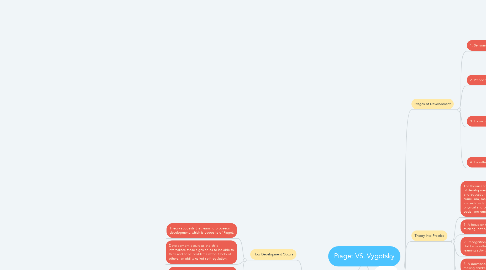
1. Vygotsky
1.1. How Development Occurs
1.1.1. Theory suggests that learning proceeds development, which is opposite of Piaget.
1.1.2. Development occurs as the child internalizes these signs so as to be able to think and solve problems without help of others, an ability called self-regulation.
1.1.3. Learning involves the acquisition of signs by means of information from others and deliberate teaching.
1.2. View Of Cognitive Development
1.2.1. Work is based on two key ideas
1.2.1.1. First, he proposed that intellectual development can be understood only in terms of the historical and cultural contexts children experience.
1.2.1.2. Secondly, he believed that development depends on the sign system that individuals grow up with: the symbols that cultures create to help people think, communicate, and solve problems.
1.2.1.2.1. Examples include a culture's language, written system, and counting system.
2. Piaget
2.1. Stages of Development
2.1.1. 1. Sensorimtor Stage
2.1.1.1. Birth to Age 2
2.1.1.2. Formation of concepts of "object permanence" and gradual progression from reflexive behavior to goal-directed behavior
2.1.2. 2. Preoperational Stage
2.1.2.1. 2 to 7 years
2.1.2.2. Development of the ability to use symbols to represent objects in the world. Thinking remains egocentric and centered.
2.1.3. 3. Formal Operational Stage
2.1.3.1. 7 to 11 years
2.1.3.2. Improvement in ability to think logically. New abilities include the use of operations that are reversible. Thinking is decentered, and problem solving is less restricted restricted by egocentrism. Abstract thinking is not yet possible.
2.1.4. 4. Hypothetical Codition
2.1.4.1. 11 years to adulthood
2.1.4.2. Abstract and purely symbolic thinking is possible. Problems can be solved through the use of systematic experimentation.
2.2. Theory Into Practice
2.2.1. The theories focused attention on the idea of developmentally appropriate education- and education with environments, curriculum, materials, and instruction that are suitable for students in term of their physical and cognitive abilities and their social and emotional needs.
2.2.2. 1. A focus on the process of children's thinking, not only its products.
2.2.3. 2. Recognition of the critical role of children's self-initiated, active involvment in learning activities.
2.2.4. 3. A deemphasis on practices aimed at making children adultlike in thier thinking
2.2.5. 4. Acceptance of individual differences in developmental progress.
2.3. How Development Occurs
2.3.1. Schemes
2.3.1.1. Young children develop patterns of behavior or thinking, called schemes
2.3.1.2. We use schemes to find out about and act in the world; each scheme treats all objects and events in the same way.
2.3.2. Assimilation and Accommodation
2.3.2.1. Adaption
2.3.2.1.1. Adaption is the process of adjusting schemes in response to the environment by means of assimilation and accommodations.
2.3.2.2. Assimilation
2.3.2.2.1. Assimilation is the process of understanding a new object or event in terms of an existing scheme.
2.3.2.3. Accommodation
2.3.2.3.1. When old ways of dealing with the world simply don't work, a child might modify an existing scheme in light of new information or a new experience, a process called accommodation.
2.3.2.4. Equilibrium/Disequilibrium
2.3.2.4.1. The process of restoring this imbalance is called equilibration. According to Piaget, learning depends on this process. When equilibrium is upset, children have the opportunity to grow and develop.
2.3.2.4.2. Piaget's theory, creates a state of disequilibrium, or an imbalance between what is understood and what is encountered.
2.3.3. Constructivism
2.3.3.1. Piaget's theory of development represents constructivism, a view of cognitive development as a process in which children actively build systems of meaning and understanding of reality through their experiences and interactions.
2.3.3.2. In this view, children actively construct knowledge by continuously assimilating and accommodating new information.

